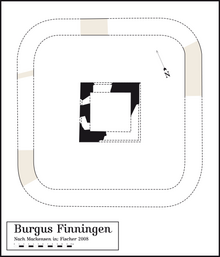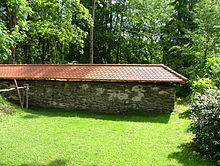Burgus Ahegg
| Burgus Ahegg | |
|---|---|
| limes | Danube-Iller-Rhine-Limes |
| Dating (occupancy) |
Tetrarchic ? / Valentine until the end of the 4th / beginning of the 5th century |
| Type | Burgus |
| size | 10.8 m × 11.0 m |
| Construction | a) wood? b) stone |
| State of preservation | Well-preserved, massive wall square |
| place | Ahegg ( Buchenberg ) |
| Geographical location | 47 ° 42 '35.4 " N , 10 ° 15' 1.1" E |
| height | 900 m above sea level NHN |
| Previous | Isny-Bettmauer Fort (west) |
| Subsequently | Kempten-Burghalde Fort (northeast) |
The Burgus Ahegg is a small Roman military site which , as a late antique residential and watchtower, was responsible for controlling a section of the imperial border along the Danube-Iller-Rhine-Limes (DIR). The remains of the plant that have been excavated and can be viewed are located in the Ahegg district of Markt Buchenberg in the Oberallgäu district in Bavaria . It is the only one of its kind in southern Germany of which remains are still above ground.
location
Between the eastern shore of Lake Constance situated castle Bregenz (Brigantium) and the late ancient garrison on the Kempten Burghalde (Cambodunum) was the so-called "dry limit" of the DIR-Limes, which was not backed by a river. The Burgus Ahegg was founded for strategic reasons on the Adelegg ridge formed by a moraine and was thus off the Roman Limes road. The elevated location of the Burgus enabled the crew to see the surrounding borderland from afar. The nearest significant Roman intervention troops on the Limes were five kilometers northeast of the Iller near Kempten and to the west in the tetrarchical cavalry fort Vemania near Isny in the Allgäu , which was built at the foot of a foothill of the Adelegg.
Research history
The Burgus in Ahegg, which was under a large rock rubble hill until it was uncovered, was excavated by the Bavarian State Office for Monument Preservation (BLfD) in 1932 . The archaeologist Wilhelm Schleiermacher (1904–1977) still considered the Roman origin of this complex in 1972 to be "uncertain". Since it was uncovered, the building remains have been repaired several times inappropriately and with non-frost-resistant mortar. It was not until 1995 that employees of the Kempten City Archeology department carried out a restoration using a special mortar. After renewed security measures taken by the archaeological working group of the Buchenberg Local History Association, a tile-covered wooden gable roof was placed on the remaining stumps in 2009/2010 to protect against further deterioration.
Building history
Towards the end of the 3rd century, the uncertain situation on many border sections of the Roman Empire stabilized for decades. Fortresses were newly built, renewed or rebuilt. Wooden watchtowers were often built between these types of garrison. Examples from the Upper Rhine and the Roman road between Augusta Vindelicorum ( Augsburg ) and Cambodunum ( Kempten ) can be dated to the reign of Emperor Constantine (306–337). In Ahegg, too, there are indications that the later stone Burgus was preceded by a wooden predecessor.
After devastating Germanic invasions, Emperor Valentinian I (364–375) put on a building program of larger and smaller fortifications (castra et castella) along the imperial borders on the Rhine (Rhenus) and Danube (Danuvius) in order to ensure the security of the empire. From 369 a large number of stone structures were built on the high Rhine ( Maxima Sequanorum province ) on the Brigantium - Cambodunum - Caelius Mons long-distance connection and on the upper and middle Danube. The conception of many of the Burgi built at the time followed a largely standardized construction scheme. A number of structural details known from Ahegg are also known from other sites. The very well-preserved Burgus Bacharnsdorf in Lower Austria also shows the rising masonry up to the second floor. For the Late Antique province Raetia II , was one of the Ahegg, although no datable inscription has been discovered to Burgi, but were especially a lot of very similar plants on the Danube limes by stratifizierbare coins, brick temple and - associated with building inscriptions of Valentinian stage - to a much lesser extent (e.g. the Burgi Visegrád-Lepence and Visegrád quarry ).
The walls of the Ahegger Burgus, which were set in mortar, were still around 1.5 meters high and were 1.2 meters thick during the excavation, consist of rolling stones, as they are on the bottom of the Rottach immediately east of the square. The fortification forms an almost square area of 10.8 × 11.0 meters, on the north side of which a 1.45 m wide gap is excluded. A post position was found in the middle of the burgus. These posts once supported the mighty roof. On the east side there was a fireplace made of brick panels. During the renovation work in 2009, it was found that a drainage made of large brook cats (river pebbles) had been laid directly around the Burgus, which had disposed of the sewage in Roman times. As an obstacle to the approach, the fortification was protected by a ditch that can still be seen today and the steeply sloping ravine towards the Rottach.
In particular, the salvaged pottery, such as grater bowls with internal glaze, is typical of many late antique military sites and settlement areas. The glazed goods first appeared in the finds in the Germanic provinces as well as in Pannonia around 320 AD and can be traced back to the late 5th century in Raetia - such as in the Künzing (Quintana) site .
The permanent guards of the Burgus can be assumed to be a dozen men who were subordinate to one of the nearest forts. The incendiary layers in Burgus, which cannot be classified with certainty in terms of time, were ascribed to the late 4th or early 5th century AD and testify to the end of Roman rule in the foothills of the Alps.
Post-Roman development
The massive remains of the Roman wall, which perhaps still stood upright in the later Middle Ages, were probably reused by the builders of a small castle and rebuilt for the new purpose. This was indicated by the medieval rubble that covered up the ancient findings during the excavation. In contrast, the archaeologist Paul Reinecke (1872–1958) assumed that the small castle, which was probably built towards the end of the High Middle Ages, was founded on the Burgus, which had already fallen into a rubble mound. This new facility brought research into connection with Ahegg Castle, mentioned in the "Martinszeller Contract" in 1525.
Monument protection
The Burgus is a registered ground monument within the meaning of the Bavarian Monument Protection Act (BayDSchG). Investigations and targeted collection of finds are subject to authorization, accidental finds must be reported to the monument authorities.
See also
List of forts in the Danube-Iller-Rhein-Limes
literature
- Paul Reinecke : New Burgi on the late Roman border of Rhaetia. In: Germania 19, 1935, pp. 135-157.
- Jochen Garbsch : The late Roman Danube-Iller-Rhein-Limes. 1970 (Small writings on the knowledge of the Roman occupation history of Southwest Germany No. 6).
Web links
Remarks
- ↑ a b Wilhelm Schleiermacher : Cambodunum-Kempten. A Roman city in the Allgäu. Rudolf Habelt Verlag, Bonn 1972.
- ↑ a b Roman watchtower in Ahegg saved. In: Allgäuer Zeitung . October 13, 2009 ( online ( page no longer available , search in web archives ) Info: The link was automatically marked as defective. Please check the link according to the instructions and then remove this notice. ).
- ↑ A roof for the watchtower. In: Allgäuer Zeitung . June 1, 2010 ( online ( page no longer available , search in web archives ) Info: The link was automatically marked as defective. Please check the link according to the instructions and then remove this notice. ).
- ↑ a b Michael Mackensen: Settlement and military border area in the lower Illertal and on the upper Danube in the late Roman Empire. In: Ulmer Museum (Hrsg.): Romans on Danube and Iller - New research and findings. Book accompanying the exhibition, Jan Thorbecke Verlag, Sigmaringen 1996, ISBN 3-7995-0410-9 , p. 149.
- ↑ a b c Michael Mackensen : Cambidanum - A late Roman garrison town on the north-western border of the province of Raetia secunda. In: Gerhard Weber (Ed.): Cambodunum - Kempten. Verlag Philipp von Zabern, Mainz 2000, ISBN 3805326912 , p. 145.
- ↑ Michael Mackensen: Settlement and military border area in the lower Illertal and on the upper Danube in the late Roman Empire. In: Ulmer Museum (Hrsg.): Romans on Danube and Iller - New research and findings. Book accompanying the exhibition, Jan Thorbecke Verlag, Sigmaringen 1996, ISBN 3-7995-0410-9 , p. 147.
- ↑ Renate Pirling: Glazed goods. In: Kurt Böhner (Ed.): The finds from the Roman graves of Krefeld-Gellep. Catalog of the graves p. 37.
- ↑ Gabriella Nádorfi: Glazed pottery in the late Roman burial fields of Pannonia. In: Zsuzsanna Bánki (ed.): Glazed ceramics in Pannonia. Exhibition catalog, König Sankt Stephan Museum, Székesfehérvár 1992, pp. 45–51.
- ↑ Harald von Petrikovits : Contributions to Roman history and archeology . Volume 2. Rheinland-Verlag, Cologne 1991, ISBN 3-7927-1222-9 , p. 241.
- ^ Friedrich Wagner: The literature on Swabian prehistory and early history 1935-1940. In: Journal of the Historical Association for Swabia. Volume 54, Book and Art Print Shop Johann Walch, Augsburg 1941, p. 463.
- ^ Paul Reinecke: Small writings on the prehistoric and early historical topography of Bavaria. Verlag Michael Laßleben, Kallmünz 1962.





